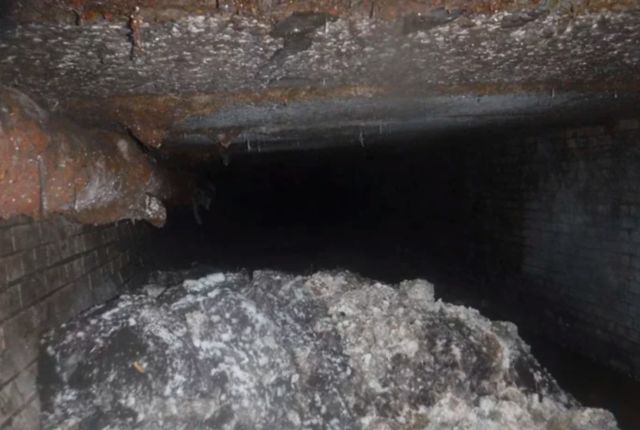Nomad
Every trumper is a N4T.
They're blaming the giant mountain of congealed fat on the large numbers of tourists who consume vast quantities of greasy fish and chips, but I think I know the real cause of it.
I think it comes from Havana 'Toon and his greasy-ass family bathing in the town sewer.
**************************************************
Englanders’ greasy fish and chips blamed for 64-meter-long fatberg
https://arstechnica.com/science/201...chips-blamed-for-64-meter-long-fatberg/?amp=1
The quiet coastal town of Sidmouth, England is known to be flush with tourists each summer. But it may now be known for another accumulating mass—one that isn’t flushable.
Authorities in Sidmouth have discovered a 64-meter-long hardened clump of grease, wet wipes, and sewage—an infamous fatberg—lurking and growing in a large sewer under the town’s waterfront. For perspective, at 64 meters, the length of the mass is greater than that of six double-decker buses end to end and the height of the Leaning Tower of Pisa.

“It is the largest discovered in our service history,” Andrew Roantree said in a statement. Roantree is the director of wastewater at South West Water, which manages the sewers in the town of about 13,000. He estimated that it will take “around eight weeks to dissect this monster in exceptionally challenging work conditions.” The team taking on the task will require “full breathing apparatus” and “special sewer jetting equipment," he said.
Of course, Sidmouth’s fatberg is not the largest ever found. In 2017, London authorities found a 250-meter-long fatberg weighing 130 metric tons in a Victorian sewer on the east side of the city. Curators at the Museum of London put chunks of it on exhibit last year as something of a “piece of 21st-century archeology.” The festering nuggets drew large crowds to the museum, and their decomposition was livestreamed from specially designed isolation boxes.
Fatbergs are a unique feature of our era and form like “snowballs,” as South West Water put it. Currently, scientists believe that when grease from cooking goes down the drain, it separates into a fatty layer on the surface of waste water and reacts with calcium deposits in a process called saponification. That reaction creates a tacky scaffold that snares sewage scraps, slowly forming a solid, reeking beast.
In an interview with The New York Times, a spokesperson for South West Waters blamed an English favorite in part for Sidmouth’s stinky monster. The annual flocks of tourists tend to feast on deep-fried fish and chips, she noted. The city’s sewers likely strain to pass the massive influx of grease.
Roantree recommended that people “put your pipes on a diet and don’t feed the fatberg.”
Removal of Sidmouth's fatberg is planned to begin in early February.

I think it comes from Havana 'Toon and his greasy-ass family bathing in the town sewer.

**************************************************
Englanders’ greasy fish and chips blamed for 64-meter-long fatberg
https://arstechnica.com/science/201...chips-blamed-for-64-meter-long-fatberg/?amp=1
The quiet coastal town of Sidmouth, England is known to be flush with tourists each summer. But it may now be known for another accumulating mass—one that isn’t flushable.
Authorities in Sidmouth have discovered a 64-meter-long hardened clump of grease, wet wipes, and sewage—an infamous fatberg—lurking and growing in a large sewer under the town’s waterfront. For perspective, at 64 meters, the length of the mass is greater than that of six double-decker buses end to end and the height of the Leaning Tower of Pisa.

“It is the largest discovered in our service history,” Andrew Roantree said in a statement. Roantree is the director of wastewater at South West Water, which manages the sewers in the town of about 13,000. He estimated that it will take “around eight weeks to dissect this monster in exceptionally challenging work conditions.” The team taking on the task will require “full breathing apparatus” and “special sewer jetting equipment," he said.
Of course, Sidmouth’s fatberg is not the largest ever found. In 2017, London authorities found a 250-meter-long fatberg weighing 130 metric tons in a Victorian sewer on the east side of the city. Curators at the Museum of London put chunks of it on exhibit last year as something of a “piece of 21st-century archeology.” The festering nuggets drew large crowds to the museum, and their decomposition was livestreamed from specially designed isolation boxes.
Fatbergs are a unique feature of our era and form like “snowballs,” as South West Water put it. Currently, scientists believe that when grease from cooking goes down the drain, it separates into a fatty layer on the surface of waste water and reacts with calcium deposits in a process called saponification. That reaction creates a tacky scaffold that snares sewage scraps, slowly forming a solid, reeking beast.
In an interview with The New York Times, a spokesperson for South West Waters blamed an English favorite in part for Sidmouth’s stinky monster. The annual flocks of tourists tend to feast on deep-fried fish and chips, she noted. The city’s sewers likely strain to pass the massive influx of grease.
Roantree recommended that people “put your pipes on a diet and don’t feed the fatberg.”
Removal of Sidmouth's fatberg is planned to begin in early February.



